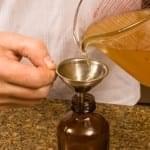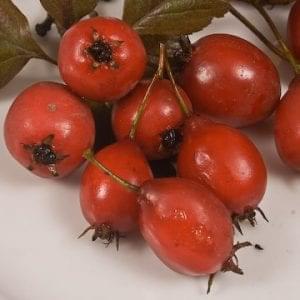An herbal liniment is a topical liquid that is designed to be rubbed in. There are many different traditions that have different bases for their traditional liniment.This procedure is very basic and can be used for many types of herbal liniments. Liniments are topical use only. They are not to be taken internally or to be placed on broken skin. They are primarily for relieving sore muscles or ligaments, reducing bruises or other skin conditions.
Most herbal liniments are based on either witch hazel, vinegar, rubbing alcohol. Some have oil in them as well. Infusing these herbs in these liquids is very simple. Liniments can be made either to warm or cool a skin condition. Just follow the directions for making infused vinegar.
The properties that you will extract will depend on your herb and the liquid you choose. For example, the vibrant red color herbalists are used to seeing in tinctures or oils made with Saint John’s wort will missing in a vinegar or witch hazel solution. Try experimenting with small batches and don’t be afraid to blend different menstruum types (solvents). If you find a great mix, be sure to send us a message at the Practical Herbalist to tell us about your success!
Herbal Liniment Making Tutorial
This is a basic procedure, not a recipe. I haven’t included specific measurements but have instead described the process and what to look for as you’re working. For specific recipes using this technique, see The Practical Herbalist Recipes.
Equipment you’ll need to make an herbal liniment:
- A cutting board and sharp knife (if you’re using fresh herbs)
- A glass jar with a tightly-fitting lid (or a similar jar made from a non-reactive material)
- A blender (optional)
- A rubber scraper or spatula, preferably one made of a material that can be thoroughly cleaned and does not hold any odors, such as a heat-proof plastic one
- A label for your jar
After the menstruum has infused, you’ll need:
- A straining bag or several layers of cheese cloth and a strainer
- A bottle for the finished liniment
- A label for your bottle
Ingredients for making an herbal liniment:
- A quantity of herbs or plant material, fresh or dried (powders are ok too)
- A penetrating liquid such as witch hazel, vinegar or rubbing alcohol
- A small quality of infused oil (optional)
Procedure for making an herbal liniment:
Prepare your herbs. If you’re using fresh herbs, you will need to clean or shake any dirt from them, although unless they’re really, really dirty you do not need to wash them with water, and you’ll need to chop them. If you plan to use a blender (see step 4), then you’ll only need to chop them roughly, but if you do not intend to use a blender, chop them as finely as you can. If you’re using dried herbs, you will need to crush them as finely as you reasonably can.
- Place the herbs into your jar. Pack them down gently and fill the jar about three-quarters of the way full with the plant material. You need to leave enough room to fill the jar with vinegar, to have room to shake the contents regularly, and to let the vinegar penetrate through all of the plant material. If you’re using roots or barks, you can fill the jar only about a third to half-way full.
Pour the menstruum over the herbs, filling the jar until you’ve covered the herbs by just under a quarter of an inch, or if you’re using barks or roots fill the jar until it’s about three quarters or so full.
- Blend the mixture until it’s smooth like a smoothie, then return it to your jar. (This step is optional if you’re using dried, hard herbs, such as dried roots, barks, or seeds.)
- Cap your jar tightly.
- Label the jar and store it in a cool, dark place. A cabinet where you’ll see it each day is ideal.
- Shake the jar daily, even several times a day. This is highly recommended, although I’ve forgotten to shake jars for weeks and still have had good results.
After two to eight weeks, strain the herb material from the menstruum. Your finished liquid should smell of the herb. As you strain it, be sure to squeeze out as much of the menstruum from the plant material as you can. I like to use a small, fine-mesh brewing bag to strain mine, but several layers of cheesecloth or a square cut from a white tshirt and a good strainer will work well, too.
Repeat these step with the other infused liniment ingredients until all of your infused herbal solvents are ready for mixing.
- Label each of your single ingredient bottles to avoid confusion later.
- Using a measuring cup, measure out your ingredients into the measuring cup, Be sure to add the optional oil last.
- A standard liniment with oil must be stirred well before pouring into the bottle. If you are pouring your liniment into several bottles, stop between the pours and stir again.
- If you are going to put your liniment with oil into a spray bottle, be aware that oil tends to clog the spray nozzle. Plan accordingly.
- Label your jar and store it in a cool, dark place. Be sure to include the date, the kind of herb you infused, and uses so others will also know how to use it.










